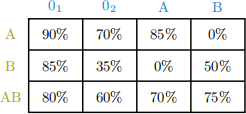Econ 521, Problem Set 11
Hello, dear friend, you can consult us at any time if you have any questions, add WeChat: daixieit
Econ 521, Problem Set 11
Problem 1. Organ donation.
Consider the problem of matching four Donor Hearts of blood types 0, 0, A, and B to three Patients of blood types A, B, and AB. Survival probability of each transplant is as follows:

The sale of human organs was outlawed in 1984. Nevertheless, we can treat this assignment problem as a matching problem with transferable utilities to guarantee an efficient match. The resulting “shadow prices” of the hearts is measured in units of life expectancy after a successful transplant. Suppose that all patients have the same life expectancy if the transplant is successful.
a. Characterize the core of the grand coalition.
Hint: Denote utilities of patient i by ui and the “price” of heart j by pj . You can find relations among prices by looking at the difference of a matched pair (i, j) with an alternate match (i, j′ ) for j′ ![]() j.
j.
b. What is the element of the core with the highest utilities for patients?
Problem 2. Forming a European government.
In many European countries, the political party that has won the most seats in the House of Representatives gets to form the government, consisting of a coalition of political parties that hold a majority of seats in the House of Representatives. Suppose that country X has five political parties: one large party holding 200 seats, a medium party holding 160 seats, and three smaller parties with 80 seats each.
a. A coalition is winning if it can form the government. What is the coalitional function of country X?
b. What is the Shapley-Shubik power index for the formation of the government?
Hint: Use symmetry where you can, and that the Shapley-Shubik power indices of all parties sum up to 1 .
2023-12-19